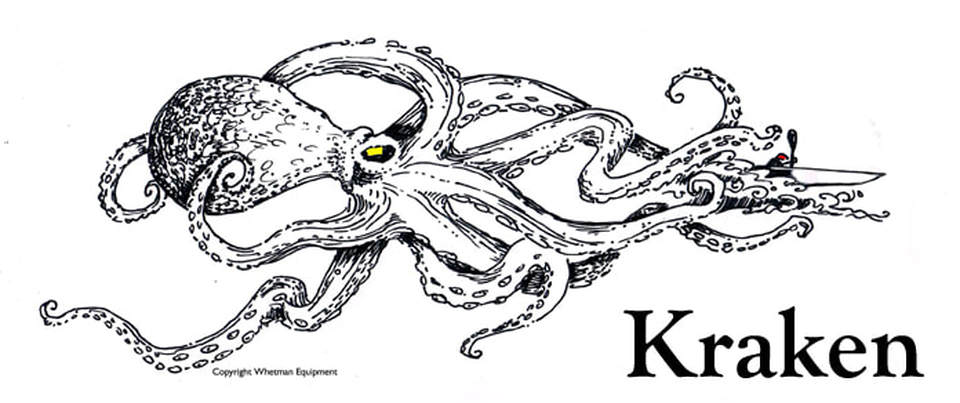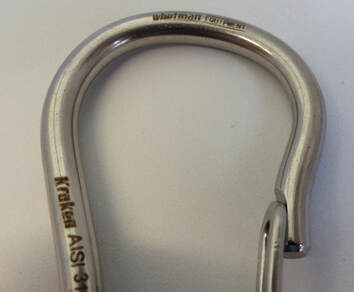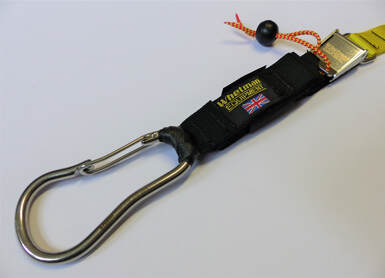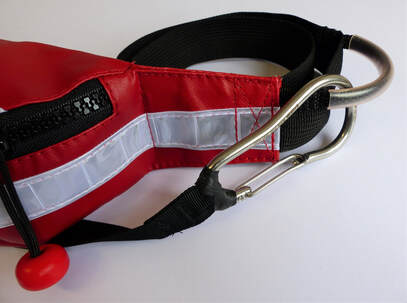trouble at sea............. unleash the Kraken
Connectors for Sea Kayak Towing - be informed of the characteristics of this piece of kit - read the article at the base of this page
|
Big enough to handle with wet cold hands Slim enough to slide under tight decklines Wiregate is simple to use and powerful enough to remain closed during deployment Notice the nose is snag free to enable easy clipping and unclipping of decklines. The wiregate sits in a curved recess so that the line will not catch on the nose whilst connected. The overall shape directs the captured line to the top of the Kraken which keeps it away from the gate. |
Kraken: karabiner for the seaStainless marine grade steel Easy clip gate Tactile in cold wet hands Snag free connector An original design by Whetman Equipment |
Connectors for Sea Kayak towing.
There are a variety of connectors used for towing sea kayaks and all have their benefits and pitfalls. There is not a perfect connector yet available for this task; each one has its limitations and it is up to the paddler to make an informed choice of what to use and then test and practise using it so as to become competent in its deployment & appreciate what it can/cannot do. This text is to assist in giving that information & we also suggest go chat to an experienced sea kayak coach!
Sea kayaking is an assumed risk activity and your rescue kit is there to help you manage that risk. However on rare occasions it may malfunction; therefore your exposure to risk should consider this & always have a back up. The connector or karabiner is a critical aspect of the sea kayak towing system. Regarding the connectors generally used they all are snag free with no hook on the nose which could snag the deckline. Most sea kayak coaches recommend clipping from underneath the deckline to reduce the chance of the clip disconnecting. All of these clips are snapgates hence they snap close on a spring and can be opened and closed very quickly; brilliant for a quick connection on a lumpy sea. This characteristic is also a potential cause of failure and can result, on rare occasions by chance, in the snapgate unclipping entirely from the deckline leaving the towed kayak at the mercy of Neptune’s wrath.
Snapgate disconnection can occur if the kayak is thrown around and lurches back and forward, up and down causing the connector & line to be tossed & twisted in all directions. With wiregate clips such as the Kraken stainless clip (and most other wiregate clips) if they run alongside the deckline on rare occasions the rope itself can catch on the gate and drag it open & disconnect. This is more prone to occur if the decklines are tight and made of cheap polypropylene rough braided lines rather than the smoother polyester decklines. So if you use these clip types practise clipping to the very front of the bow to prevent this. The benefit of wiregate clips is the spring is very simple and will not jam or corrode given it is created by eccentric loading of tensioned maintenance free stainless steel – clever stuff! Lets compare this to a connector with a solid gate. These clips have an internal tube with a traditional spring which can jam with dirt and salt crystals; so although these are less likely (still possible though) to disconnect from a line, they may jam open or closed when you need them most! Even when scrupulously maintained these clips can fail as a result of exposure to a marine environment. There are also some plastic clips used and issued on products; they are quite small & chunky with a leaf type gate and are light and relatively cheap. The maximum strength of these is much lower than a metal clip so consider what types of situations you will be in and make an informed decision. Some coaches will insist on these being replaced before launching!
In rock climbing snapgates are recognised as a risky connection and are not used for critical rigging; that task is for a screwgate connector; a threaded collar is screwed over the gate to stop it opening. The screwgate connector is another option to consider. If you intend to be in demanding high risk situations where a towline connection must be super reliable then a screwgate clip is the tool for the job. Stop! Its not that simple of course given the collar could jam with sand/salt/corrosion, and also the spring could fail, so if you decide on one of these be extremely vigilant with maintenance and lubrication.
So as yet there is no perfect connector and hopefully this information will help you decide what to use and recognise the limitations of your choice. My company is striving to develop new ideas for a more versatile connection system and we haven’t yet got the perfect design so watch this space!
Steve Whetman
Whetman Equipment
There are a variety of connectors used for towing sea kayaks and all have their benefits and pitfalls. There is not a perfect connector yet available for this task; each one has its limitations and it is up to the paddler to make an informed choice of what to use and then test and practise using it so as to become competent in its deployment & appreciate what it can/cannot do. This text is to assist in giving that information & we also suggest go chat to an experienced sea kayak coach!
Sea kayaking is an assumed risk activity and your rescue kit is there to help you manage that risk. However on rare occasions it may malfunction; therefore your exposure to risk should consider this & always have a back up. The connector or karabiner is a critical aspect of the sea kayak towing system. Regarding the connectors generally used they all are snag free with no hook on the nose which could snag the deckline. Most sea kayak coaches recommend clipping from underneath the deckline to reduce the chance of the clip disconnecting. All of these clips are snapgates hence they snap close on a spring and can be opened and closed very quickly; brilliant for a quick connection on a lumpy sea. This characteristic is also a potential cause of failure and can result, on rare occasions by chance, in the snapgate unclipping entirely from the deckline leaving the towed kayak at the mercy of Neptune’s wrath.
Snapgate disconnection can occur if the kayak is thrown around and lurches back and forward, up and down causing the connector & line to be tossed & twisted in all directions. With wiregate clips such as the Kraken stainless clip (and most other wiregate clips) if they run alongside the deckline on rare occasions the rope itself can catch on the gate and drag it open & disconnect. This is more prone to occur if the decklines are tight and made of cheap polypropylene rough braided lines rather than the smoother polyester decklines. So if you use these clip types practise clipping to the very front of the bow to prevent this. The benefit of wiregate clips is the spring is very simple and will not jam or corrode given it is created by eccentric loading of tensioned maintenance free stainless steel – clever stuff! Lets compare this to a connector with a solid gate. These clips have an internal tube with a traditional spring which can jam with dirt and salt crystals; so although these are less likely (still possible though) to disconnect from a line, they may jam open or closed when you need them most! Even when scrupulously maintained these clips can fail as a result of exposure to a marine environment. There are also some plastic clips used and issued on products; they are quite small & chunky with a leaf type gate and are light and relatively cheap. The maximum strength of these is much lower than a metal clip so consider what types of situations you will be in and make an informed decision. Some coaches will insist on these being replaced before launching!
In rock climbing snapgates are recognised as a risky connection and are not used for critical rigging; that task is for a screwgate connector; a threaded collar is screwed over the gate to stop it opening. The screwgate connector is another option to consider. If you intend to be in demanding high risk situations where a towline connection must be super reliable then a screwgate clip is the tool for the job. Stop! Its not that simple of course given the collar could jam with sand/salt/corrosion, and also the spring could fail, so if you decide on one of these be extremely vigilant with maintenance and lubrication.
So as yet there is no perfect connector and hopefully this information will help you decide what to use and recognise the limitations of your choice. My company is striving to develop new ideas for a more versatile connection system and we haven’t yet got the perfect design so watch this space!
Steve Whetman
Whetman Equipment









